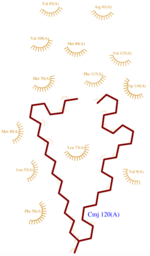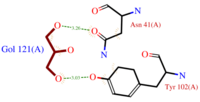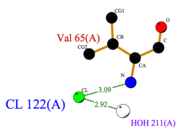The protein AmelASP1 has been identified in the antennae from the honeybee A.mellifera. Its primary sequence is a 144 amino acids polypeptide with a molecular weight of 13.180 kDa. AmelASP1 is part of the Pheromone Binding Protein (PBP) family. The 3D representation shown below was obtained at pH 5.5 using the nano-drops technique.
Biological function
As many other social insects, honeybees employ a large varsity of pheromones to ensure intraspecific communication in several behavioral contexts.
The social organization of the hive is strongly determined by chemical signals, also known as pheromones, that are actively produced and transmitted by the queen.
Social relevance
The diet of workers bees and queen bee is strongly different and determinates diverse behaviours.
Workers bee are fed with royal jelly for only three days after egg-laying whereas the queen bee eats royal jelly during her whole life. She controls the activity of each bees by chemical communication.
Actually, the queen bee is the only one able to produce 9-ODA - the main component of its pheromone which induces sexual or endocrine responses. This substance is sent to the workers bees which detect it through pheromone-binding proteins (PBPs). It is then transformed in 9-HDA and added in the royal jelly. This last substance is eaten by the queen. In turn, queen bee transforms 9-HDA into 9-ODA.
Thus, ASP1 is primordial to the internal pheromon’s transport cycle in the hive. By binding the component of queen bee pheromon, bees express and transmit essential behaviour within the hive. Indeed, 9-ODA is responsible, among others, of preventing workers bees’ ovarian developpment.
Location in the antenna and transport of pheromones
ASP1 is a protein which is only produced in the antenna of drones and workers bees. This organ constitutes one major component of the bees’ olfactory system. Cuticules structures of these antennas shelter sensillae which are a gate for pheromones. These sensillae contain neurons. Branched ending are surrounded with sensillar lymph where ASP1 captures 9-ODA and transports it to pheromone receptor in the neuron membrane. PBP’s function is to solubilize hydrophobic odorant molecules, prevent their degradation and to transport them to reach the olfactory receptor.
Structure
Domains and family
The C terminal(scene) domain of this molecule presents a characteristic PBP-GOP domain. While this protein is composed of 144 residues the domain PBP begin at the 25th residue. AmelASP1 binds its ligand at low pH and releases it at neutral pH.
Key residues
AmelASP1 is composed of 7 right-handed alpha helices
H1: residues 8–25
H2: residues 27–36
H3: residues 42–56
H4: residues 66–74
H5: residues 75–77 (rarely mentionned in publications because of its tiny size)
H6: residues 78–90
H7: residues 96–112
H1 has a break in the hydrogen-bonding pattern of its structure, forming tight substitute hydrogen bonds with water molecules. Thus, it results in a kink (at residue Ala 14) induced by a disruption in the helical conformation, due to hydrogen bonds with water molecules.
Components implicated in the structure rigidity
AmelASP1 presents three disulfide bridges which are greatly enhancing its structure’s rigidity by linking four of the helices together. The six cysteines and their interval spacing are the most striking features shared by proteins belonging to the PBP family.
The first disulfide bridge is established between H1 and H3 through Cysteins 20 and 51. An other disulfide bridge linksH3 and H6 through Cys 47 and 98, and the third disulfide bridge connects H5 and H6 thanks to Cys 89 and Cys 107.
Furthermore, non covalent bonds also play an important role.
Indeed, at pH 5.5, Asp 66 and Leu 58 establish an hydrogene bond which is able to fix a key component structure such as H4.
Cavity
The dynamic structure of the protein is responsible of the ligand’s binding by adjustment of position. In fact, this conformational flexibility is the key factor for regulating the interaction of ASP1 and its ligands. The structure looses its flexibility when CMJ binds. The successful delivery of the effector to the receptor relies on this property. The ligand binding pocket consists in a cavity formed by the helices H2, H4 and H5(scene), arranged in a globular shape which leads to a clear separation of the ligand from the hydrophilic environment.The top of the cavity is not closed and can establish contacts with the solvent. The cavity is prone to accept ligand such as 9-ODA because of its specific composition. Indeed, cavity's components are mainly hydrophobic and aromatic.They consequently interact with the ligand's hydrophobic carbon chain and are localized on the internal face of the helix.Thus, it implies that these residues respect a regular distance pattern in the primary structure of the AmelASP1.
Then, ionizable residues (scene) affected by pH changing are far away from this cavity.
[1]
[2]
[3]
[4]
Structure
Domains and family
The C terminal(scene) domain of this molecule presents a characteristic PBP-GOP domain. While this protein is composed of 144 residues the domain PBP begin at the 25th residue. AmelASP1 binds its ligand at low pH and releases it at neutral pH.
Key residues
AmelASP1 is composed of [5]
- : residues 8–25
- : residues 27–36
- : residues 42–56
- : residues 66–74
- : residues 75–77 (rarely mentionned in publications because of its tiny size)
- : residues 78–90
- : residues 96–112
has a break in the hydrogen-bonding pattern of its structure, forming tight substitute hydrogen bonds with water molecules. Thus, it results in a (at residue Ala 14) induced by a disruption in the helical conformation, due to hydrogen bonds with water molecules.
Components implicated in the structure rigidity
AmelASP1 presents which are greatly enhancing its structure’s rigidity by linking four of the helices together. The six cysteines and their interval spacing are the most striking features shared by proteins belonging to the PBP family.
The is established between and through Cysteins 20 and 51. links and through Cys 47 and 98, and the connects and thanks to Cys 89 and Cys 107.
Furthermore, non covalent bonds also play an important role.
Indeed, at pH 5.5, among the numerous other, two hydrogene bonds are particularly noticeable because of their importance in the formation of the loop stabilizing H4. is established by Asp 66 and Leu 58 whereas is formed between Asp 60 and Ala 63.
Cavity
The dynamic structure of the protein is responsible of the ligand’s binding by adjustment of position. The structure looses its flexibility when binds. The successful delivery of the effector to the receptor relies on this property. The ligand binding pocket consists in a cavity formed by the helices H2, H4 and H5(scene), arranged in a globular shape which leads to a clear separation of the
ligand from the hydrophilic environment.
The top of the cavity is not closed and can establish contacts with the solvent. The cavity is prone to accept ligand such as 9-ODA because of its specific composition. Indeed, cavity's components are mainly .They consequently interact with the ligand's hydrophobic carbon chain and are localized on the internal face of the helix.Thus, it implies that these residues respect a regular distance pattern in the primary structure of the AmelASP1.
pH influence
Updated on 23-December-2014
Ligands
Artificial ligands
Natural ligands
Related structures
These structures shown below representing the same protein with variable ligand and pH emphasize and illustrate the binding versatility of PBP.
- 3fe8 The same protein in complex with a serendipitous ligand soaked at pH 4.0
- 3fe9 The same protein in complex with a serendipitous ligand soaked at pH 7.0
- 3cdn The same protein in apo form soaked at pH 4.0
- 2h8v The same protein in apo form at pH 5.5
- 3cz2 The same protein in apo form at pH 7.0
- 3bfa The same protein in complex with the QMP at pH 5.5
- 3bfb The same protein in complex with the 9-ODA at pH 5.5
- 3bfh The same protein in complex with the HDOA at pH 5.5
- 3bjh The same protein in complex with the nBBSA at pH 5.5
- 3cyz The same protein in complex with the 9-ODA at pH 7.0
- 3cz0 The same protein in complex with the QMP at pH 7.0
- 3cz1 The same protein in complex with the nBBSA at pH 7.0
- 3cab The same protein in complex with the nBBSA soaked at pH 7.0
Relevance
Structural highlights
This is a sample scene created with SAT to by Group, and another to make of the protein. You can make your own scenes on SAT starting from scratch or loading and editing one of these sample scenes.



